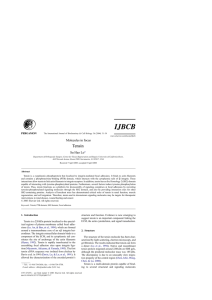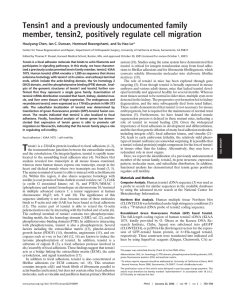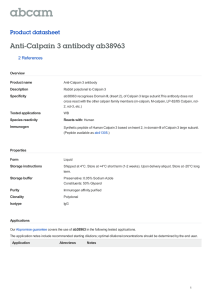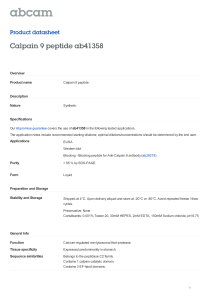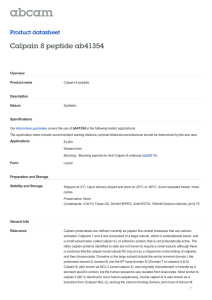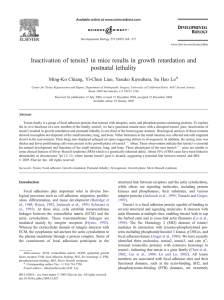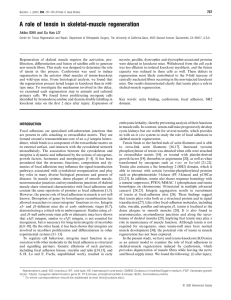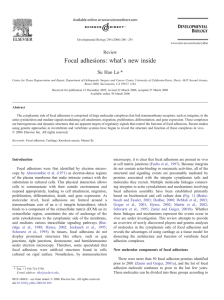Molecular characterization of human tensin Huaiyang CHEN*, Akiko ISHII*, Wai-Keung WONG 403
advertisement
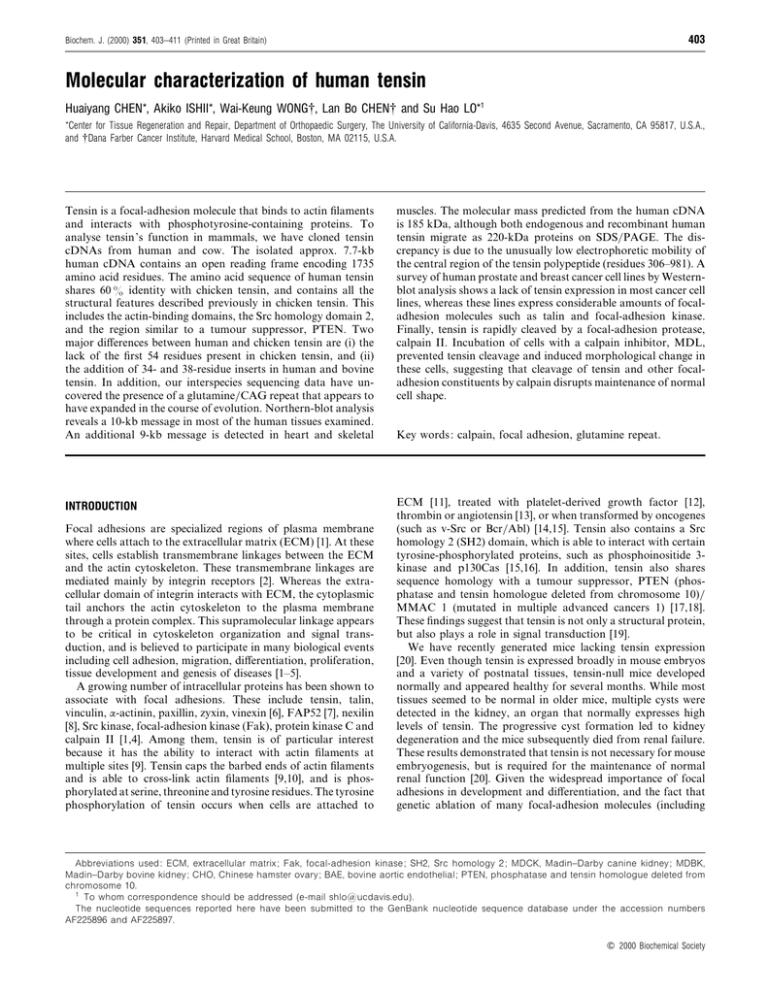
403 Biochem. J. (2000) 351, 403–411 (Printed in Great Britain) Molecular characterization of human tensin Huaiyang CHEN*, Akiko ISHII*, Wai-Keung WONG†, Lan Bo CHEN† and Su Hao LO*1 *Center for Tissue Regeneration and Repair, Department of Orthopaedic Surgery, The University of California-Davis, 4635 Second Avenue, Sacramento, CA 95817, U.S.A., and †Dana Farber Cancer Institute, Harvard Medical School, Boston, MA 02115, U.S.A. Tensin is a focal-adhesion molecule that binds to actin filaments and interacts with phosphotyrosine-containing proteins. To analyse tensin ’s function in mammals, we have cloned tensin cDNAs from human and cow. The isolated approx. 7.7-kb human cDNA contains an open reading frame encoding 1735 amino acid residues. The amino acid sequence of human tensin shares 60 % identity with chicken tensin, and contains all the structural features described previously in chicken tensin. This includes the actin-binding domains, the Src homology domain 2, and the region similar to a tumour suppressor, PTEN. Two major differences between human and chicken tensin are (i) the lack of the first 54 residues present in chicken tensin, and (ii) the addition of 34- and 38-residue inserts in human and bovine tensin. In addition, our interspecies sequencing data have uncovered the presence of a glutamine\CAG repeat that appears to have expanded in the course of evolution. Northern-blot analysis reveals a 10-kb message in most of the human tissues examined. An additional 9-kb message is detected in heart and skeletal muscles. The molecular mass predicted from the human cDNA is 185 kDa, although both endogenous and recombinant human tensin migrate as 220-kDa proteins on SDS\PAGE. The discrepancy is due to the unusually low electrophoretic mobility of the central region of the tensin polypeptide (residues 306–981). A survey of human prostate and breast cancer cell lines by Westernblot analysis shows a lack of tensin expression in most cancer cell lines, whereas these lines express considerable amounts of focaladhesion molecules such as talin and focal-adhesion kinase. Finally, tensin is rapidly cleaved by a focal-adhesion protease, calpain II. Incubation of cells with a calpain inhibitor, MDL, prevented tensin cleavage and induced morphological change in these cells, suggesting that cleavage of tensin and other focaladhesion constituents by calpain disrupts maintenance of normal cell shape. INTRODUCTION ECM [11], treated with platelet-derived growth factor [12], thrombin or angiotensin [13], or when transformed by oncogenes (such as v-Src or Bcr\Abl) [14,15]. Tensin also contains a Src homology 2 (SH2) domain, which is able to interact with certain tyrosine-phosphorylated proteins, such as phosphoinositide 3kinase and p130Cas [15,16]. In addition, tensin also shares sequence homology with a tumour suppressor, PTEN (phosphatase and tensin homologue deleted from chromosome 10)\ MMAC 1 (mutated in multiple advanced cancers 1) [17,18]. These findings suggest that tensin is not only a structural protein, but also plays a role in signal transduction [19]. We have recently generated mice lacking tensin expression [20]. Even though tensin is expressed broadly in mouse embryos and a variety of postnatal tissues, tensin-null mice developed normally and appeared healthy for several months. While most tissues seemed to be normal in older mice, multiple cysts were detected in the kidney, an organ that normally expresses high levels of tensin. The progressive cyst formation led to kidney degeneration and the mice subsequently died from renal failure. These results demonstrated that tensin is not necessary for mouse embryogenesis, but is required for the maintenance of normal renal function [20]. Given the widespread importance of focal adhesions in development and differentiation, and the fact that genetic ablation of many focal-adhesion molecules (including Focal adhesions are specialized regions of plasma membrane where cells attach to the extracellular matrix (ECM) [1]. At these sites, cells establish transmembrane linkages between the ECM and the actin cytoskeleton. These transmembrane linkages are mediated mainly by integrin receptors [2]. Whereas the extracellular domain of integrin interacts with ECM, the cytoplasmic tail anchors the actin cytoskeleton to the plasma membrane through a protein complex. This supramolecular linkage appears to be critical in cytoskeleton organization and signal transduction, and is believed to participate in many biological events including cell adhesion, migration, differentiation, proliferation, tissue development and genesis of diseases [1–5]. A growing number of intracellular proteins has been shown to associate with focal adhesions. These include tensin, talin, vinculin, α-actinin, paxillin, zyxin, vinexin [6], FAP52 [7], nexilin [8], Src kinase, focal-adhesion kinase (Fak), protein kinase C and calpain II [1,4]. Among them, tensin is of particular interest because it has the ability to interact with actin filaments at multiple sites [9]. Tensin caps the barbed ends of actin filaments and is able to cross-link actin filaments [9,10], and is phosphorylated at serine, threonine and tyrosine residues. The tyrosine phosphorylation of tensin occurs when cells are attached to Key words : calpain, focal adhesion, glutamine repeat. Abbreviations used : ECM, extracellular matrix ; Fak, focal-adhesion kinase ; SH2, Src homology 2 ; MDCK, Madin–Darby canine kidney ; MDBK, Madin–Darby bovine kidney ; CHO, Chinese hamster ovary ; BAE, bovine aortic endothelial ; PTEN, phosphatase and tensin homologue deleted from chromosome 10. 1 To whom correspondence should be addressed (e-mail shlo!ucdavis.edu). The nucleotide sequences reported here have been submitted to the GenBank nucleotide sequence database under the accession numbers AF225896 and AF225897. # 2000 Biochemical Society 404 H. Chen and others vinculin, Fak and integrins α5 and β1) leads to early embryonic lethality, the relatively mild phenotypes of tensin-null mice are somewhat surprising. It is possible that a related protein may compensate for the loss of tensin in tissues other than the kidney, or that other actin-binding proteins localized at focal adhesions may perform similar functions to tensin. Thus far, the complete tensin cDNA sequence has only been reported from an avian source [10,14,21]. To identify the sequences in tensin that are central to its function and to develop materials to facilitate the study of tensin in humans, we have initiated an effort to identify and characterize human tensin. Here we report the sequence, expression pattern, subcellular distribution, protein electrophoretic mobility and the calciumdependent proteolysis of human tensin. In addition, we have tantalizing data correlating loss of the protein with tumorigenic progression, and our interspecies sequencing data have uncovered an unstable triplet repeat in the human protein that may also play a role in the genesis of human disease. MATERIALS AND METHODS cDNA cloning and sequencing Chicken tensin cDNA fragments were used as probes to screen human heart and bovine pericyte cell λgt 11 cDNA libraries by a standard procedure [21]. Four human and three bovine clones were isolated and sequenced. Recombinant epitope-tagged human tensin and its fragments A human tensin cDNA containing the full-length open reading frame was subcloned using overlapping clones. Oligonucleotidedirected PCR mutagenesis was used to engineer a 6iHis-tag followed by a stop codon at the C-terminus. Recombinant proteins were expressed from tensin cDNA fragments cloned into the EcoRI site of pcDNA3.1\His vector (Invitrogen, Carlsbad, CA, U.S.A.) using the TnT T7-coupled reticulocyte lysate system (Promega, Madison, MI, U.S.A.). The resultant constructs use the vector start codon, followed by 40 amino acids of irrelevant sequence preceding the tensin sequence. Northern-blot analysis Human multiple-tissue Northern blots (Clontech, Palo Alto, CA, U.S.A.) were hybridized under high-stringency conditions [20] with a $#P-labelled cDNA probe of 1.9 kb corresponding to human tensin amino acid residues 1–648. Human breast cell lines MCF-10A, MCF-7, MDA-MB-231, MDA-MB-435, MDA-MB453 and MDA-MB-468 were gifts from Dr Mien-Chie Hung (M. D. Anderson Cancer Center, Houston, TX, U.S.A.). Prostate cell lines MLC-SV40, LnCap, PC3, DU145 and CWR22R were provided kindly by Dr Clifford Tepper and Dr Paul Gumerlock (University of California-Davis Cancer Center, Sacramento, CA, U.S.A.). Madin–Darby canine kidney (MDCK), Madin– Darby bovine kidney (MDBK), Chinese hamster ovary (CHO) and NIH 3T3 cells were purchased from A. T. C. C. Bovine aortic endothelial (BAE) cells were purchased from Clonetics (San Diego, CA, U.S.A.). Fluorescence microscopy NIH 3T3 cells grown on glass coverslips were transfected with 6iHis-tagged human tensin cDNA in the pRcCMV vector (Invitrogen) using SuperFect transfection reagent (Qiagen, Valencia, CA, U.S.A.). After 24 h, cells were fixed with methanol at k20 mC for 10 min. After rinsing with PBS, cells were incubated # 2000 Biochemical Society with a rabbit polyclonal antibody specific for the 6iHis tag for 1 h at 37 mC. Upon 45 min of incubation with Texas Redconjugated goat anti-rabbit antibodies, cells were visualized with a Zeiss Axioplan microscope equipped with epifluorescent optics. Immunoblotting Cell cultures were treated with lysis buffer (50 mM Tris, pH 7.5, 150 mM NaCl, 1 mM EDTA and 1 % Nonidet P-40), including protease inhibitors (1 mM PMSF, 10 µg\ml leupeptin and 10 µg\ml pepstatin). Samples were centrifuged at maximum speed in a microfuge at 4 mC for 15 min. Protein concentration was measured using Bio-Rad protein assay reagent. Protein (60 µg) was subjected to SDS\PAGE on a 10 % gel as described in [22]. Proteins were then transferred on to nitrocellulose membrane that was stained with Ponceau S to verify equal loading and transfer. The membrane was incubated with blocking solution containing 5 % skimmed milk in TBST (50 mM Tris\ HCl, pH 7.5, 150 mM NaCl and 0.1 % Tween 20) for 1 h at room temperature. The membrane was incubated with primary antibody in blocking solution at room temperature for 1 h. After washing with TBST for 10 min, the membrane was incubated with horseradish peroxidase-conjugated anti-mouse or antirabbit IgG for 1 h at room temperature. After washing three times, the bound antibody was visualized using the ECL2 Western-blotting reagent (Amersham). Generation of tensin antibodies Glutathione S-transferase–tensin fusion proteins encoding amino acid residues 985–1149 (corresponding to the bovine sequence), were purified and injected in rabbits for antiserum (R95) production as described in [21]. Proteolytic digestion In itro transcription and translation of [$&S]methionine-labelled human tensin and its fragments was performed with the TnT T7coupled reticulocyte lysate system (Promega) according to the manufacturer’s instructions. Reaction mixture (1 µl) was incubated with or without 0.2 activity units\µl of purified calpain II (Calbiochem, San Diego, CA, U.S.A.) for 30 min at 30 mC in 50 mM Tris\HCl (pH 7.5)\1 mM dithiothreitol in the presence or absence of 10 mM CaCl . The digestion was terminated by # boiling the sample with an equal volume of 2igel sample buffer. The resultant proteolytic peptides were separated on SDS\ polyacrylamide gels, and gels were dried on Whatman filter paper using the sequencing dryer, and analysed by autoradiography as described in [23]. To inactivate calpain activity in cell culture, the membranepermeable inhibitor, MDL (Novabiochem, San Diego, CA, U.S.A.), was used. MDL was dissolved in DMSO at 150 mM to make a 1000i stock solution. BAE cells were grown in EGM medium (Clonetics). MDL was then added to the fresh EGM medium at the final concentration of 150 µM. Control cells received an equal volume of DMSO. Cells were harvested at the indicated time for immunoblot analysis. RESULTS Cloning of human and bovine tensin cDNAs The structure of human tensin was deduced from a series of overlapping cDNA clones isolated from a human heart cDNA library using chicken tensin cDNA as a probe. A composite region of 7764 nucleotides was identified. A 2-kb 5h-untranslated Molecular characterization of human tensin Figure 1 405 For legend see opposite page. region precedes a potential initiator methionine, followed by a single open reading frame of 5205 bp predicted to encode 1735 amino acids with a calculated molecular mass of 185 kDa. A 3huntranslated region of 559 bp was identified. A polyadenylation signal was not found within this region, and we predict this to be further downstream in the cDNA, as was found in the chicken gene [24]. In addition, we also isolated a series of cDNA clones from cow. A total of 7164 bp with a single open reading frame of 5145 bp of bovine tensin cDNA were identified. The predicted amino acid sequence of bovine tensin is highly related to human, with an overall 82 % amino acid identity, and both species share about 60 % sequence identity with their chicken homologue. The amino acid sequence alignment was interrupted by several 5–14residue insertions found mainly in chicken tensin (Figure 1), and longer inserts (34 and 38 residues) were found in human and cow. Human and bovine tensin do not contain sequence corresponding to chicken residues 1–54, suggesting either species variation or that the methionine at position 55 may be the initiator for chicken tensin as well as in human and cow. The functional domains described previously for chicken tensin appear to be # 2000 Biochemical Society 406 Figure 1 H. Chen and others Alignment of human, cow and chicken tensin amino acid sequences Identical residues are indicated by asterisks and similar residues are labelled with a dot. PGSP repeats are shown in bold and the SH2 domains are boxed. Figure 2 Tissue distribution of tensin mRNA Northern-blot analysis of tensin in human tissues (top panel, long exposure ; middle panel, short exposure). Lanes : 1, brain ; 2, heart ; 3, skeletal muscle ; 4, colon ; 5, thymus ; 6, spleen ; 7, kidney ; 8, liver ; 9, small intestine ; 10, placenta ; 11, lung and 12, peripheral blood leucocyte. Hybridization analysis of the same blot by using β-actin cDNA probe is shown in the bottom panel as a normalization control. The smaller-sized bands appearing in lanes 2 and 3 correspond to the expected size of α-actin mRNA. Arrows indicate two tensin messages. # 2000 Biochemical Society preserved, including the actin-binding domains (human tensin residues 1–198 and 198–394), the SH2 domain (residues 1463–1571), and the region similar to PTEN (residues 12–227). Upon further analysis of tensin sequences, we identified a PGSP(S\C\G)L(G\D\C)RH sequence that repeats twice in chicken and four times in human and cow. In addition to the full peptide, the half peptide PGSP repeats three times in chicken and once in human and cow. The function of these repeats is not known at present. Interestingly, both human and bovine tensin contain glutamine\CAG repeats in the coding region 651–659 in human and 651–662 in cow. The expansion of this type of repeat has been identified in numerous neurodegenerative and muscular diseases, among them Huntington ’s disease. The expression of tensin in human tissues was examined by Northern-blot analysis. It revealed a major 10-kb message in most of the tissues examined, with higher levels in human heart, skeletal muscle, kidney and lung (Figure 2). There appears to be another 9-kb message in heart and skeletal muscle. In the case of skeletal muscle, expression levels of both messages are relatively equal. In contrast, the 10-kb message seems predominant in heart. Focal-adhesion localization and molecular mass of human tensin To analyse protein subcellular localization of human tensin, an expression construct containing the full-length tensin cDNA Molecular characterization of human tensin Figure 5 Figure 3 Localization of recombinant tensin at focal adhesions NIH 3T3 cells grown on coverslips were transfected with 6iHis-tagged human tensin constructs. Cells were fixed and stained with anti-6iHis antibody. Recombinant tensin was localized to focal adhesions in transfected cells (arrowheads). No focal-adhesion labelling was detected in non-transfected cells (arrows). 407 Apparent molecular masses of tensin fragments The in vitro-transcribed/translated and [35S]methionine-labelled fragments encompassing residues 1–306 (lane 1), 306–649 (lane 2), 712–1168 (lane 3), 981–1340 (lane 4), 1261–1591 (lane 5) and 1468–1735 (lane 6) of human tensin were resolved by SDS/PAGE (15 % gel) and detected by autoradiography. Predicted molecular masses were calculated from cDNA-deduced amino acid sequence plus linker sequence (4 kDa). Apparent molecular masses were estimated by interpolation from the curves of log(molecular mass) versus Rf. Figure 4 Apparent molecular masses of recombinant human tensin and endogenous tensin from different species Top panel : recombinant human tensin synthesized by in vitro transcription/translation (lane 2) or by transfected (lane 3) or non-transfected (lane 4) NIH 3T3 cells was immunoprecipitated with anti-6iHis antibody which recognized the epitope tag. The associated proteins were detected by Western-blot analysis using anti-tensin antibody (R95). Whole cell lysate from normal human fibroblasts was used to detect the endogenous tensin (lane 1). Lower panel : cell lysate from human fibroblasts (HF), NIH 3T3 cells, MDCK cells, MDBK cells, CHO cells and chick embryo fibroblasts (CEF) resolved by SDS/PAGE, transferred to nitrocellulose membrane, and blotted with anti-tensin antibody (R95). Note that tensins from human and mouse (arrowhead) migrated more slowly than those from other species (arrow). The lower-molecularmass materials present in HF, MDCK and CEF lanes are presumably degradation products. with a 6iHis tag at the C-terminus was assembled for use in transfection assays. The localization of 6iHis-tagged recombinant tensin was monitored using anti-6iHis antibodies. As shown in Figure 3, we detected a specific focal-adhesion staining in the transfected cells, but not in the non-transfected cells. The expression of recombinant tensin was confirmed further by immunoprecipitation with anti-6iHis antibodies followed by Western blotting with anti-tensin antibodies (Figure 4, top panel). Although the predicted molecular mass was 185 kDa, recombinant tensin migrated at around 220 kDa on SDS gels. To analyse the molecular mass of endogenous tensin in different species, human fibroblasts, mouse NIH 3T3 cells, MDBK cells, MDCK cells, CHO cells and chick embryo fibroblasts were used Figure 6 Tensin expression in breast and prostate cancer cell lines Equal amounts of cell-lysate protein (60 µg) from MCF-10A (lane 1), MDA-MB-435 (lane 2), MDA-MB-231 (lane 3), MDA-MB-453 (lane 4), MDA-MB-468 (lane 5), MCF-7 (lane 6), MLCSV40 (lane 7), LnCap (lane 8), CWR22R (lane 9), PC3 (lane 10), and DU145 (lane 11) cell lines were probed with anti-tensin antibody (top panel). Blots were stripped and reprobed with antitalin (middle panel) and anti-Fak antibodies (bottom panel). for Western-blot analysis. As shown in Figure 4, bottom panel, a band around 220 kDa was detected in each sample. Tensin was slightly larger in human and mouse fibroblasts. From these results, we concluded that (i) tensin is a focal-adhesion molecule, (ii) recombinant and endogenous tensin migrated more slowly than expected based on their predicted molecular masses and (iii) tensin is expressed in different species from avian to human and in fibroblasts, epithelial cells and myoblasts (results not shown). To characterize the discrepancy between the predicted molecular mass of 185 kDa and the apparent molecular mass of 220 kDa, a series of recombinant tensin fragments were expressed by in itro transcription\translation and their apparent molecular masses were assayed by SDS\PAGE. Although most tensin fragments (1–306, 981–1340, 1261–1591 and 1468–1735) migrated as predicted, the fragments containing tensin 306–649 and 712–1168 migrated much more slowly (Figure 5). Although # 2000 Biochemical Society 408 Figure 7 H. Chen and others Tensin proteolysis by calpain II Left-hand panel : recombinant tensin was incubated without calpain II (lane 1), with calpain II (0.2 unit/µl) and in the presence of calcium (lane 2), or with calpain but in the absence of calcium (lane 3) at 30 mC for 30 min. Right-hand panel : [35S]methionine-labelled tensin fragments from the in vitro transcription/translation were incubated with (j) or without (k) calpain (0.02 unit/µl) at 30 mC for 30 min, then the reactions were resolved by SDS/PAGE (15 % gels). Gels were dried on to Whatman filter paper using a sequencing drier and analysed by autoradiography. Arrows indicate proteolytic products. Asterisks show the intact tensin. DMSO 16h MDL 16h Figure 8 Effect of MDL on tensin cleavage and the morphology of BAE cells Left-hand panel : BAE cells were allowed to grow overnight, and then MDL was added to the culture medium (150 µM in DMSO). Control cells received an equal volume of DMSO. At the indicated times, cells were harvested for Western-blot analysis. Samples of 60 µg were resolved on an SDS/polyacrylamide gel (10 %), transferred to nitrocellulose, and then probed with anti-tensin antibody. The arrow shows the 40-kDa proteolytic product. Right-hand panels : BAE cells incubated with DMSO (upper panel) or MDL (lower panel) for 16 h were examined under a light microscope. fragment 306–649 was predicted to migrate as a 40-kDa protein (with the linker sequence), it appeared to be approx. 60 kDa. Also, in spite of the fact that fragment 712–1168 was expected to migrate as a 52-kDa protein, it migrated as a 70-kDa protein. These results indicate that the central region (306–1168) of tensin possesses an unusually slow migration property on SDS gels, and the residues spanning 306–981 are probably responsible for this discrepancy, since fragment 981–1340 migrated normally. Tensin expression in human cancer cell lines To explore the potential role of tensin in cell transformation, we have examined the protein levels of tensin in human cancer cell # 2000 Biochemical Society lines. Human breast cancer cell lines (MDA-MB-231, MDAMB-435, MDA-MB-453, MDA-MB-468 and MCF-7) and a spontaneously immortalized, non-transformed breast epithelial line (MCF-10A) were analysed by Western blotting with antitensin antibody (Figure 6). While every cell line expressed considerable amounts of focal-adhesion molecules such as talin and Fak, we only detected the 220-kDa tensin in MCF-10A and MDA-MB-468. No signal was detected in MDA-MB-435, MDAMB-231 or MCF-7, and a smaller immunoreactive band around 190-kDa was detected in MDA-MB-453. Similar results were found in prostate cancer cell lines. Whereas tensin was detected as a 220-kDa protein in an immortalized, non-transformed prostate epithelial line (MLC-SV40) [25], no band was detected Molecular characterization of human tensin in the prostate cancer cell lines LnCap, DU145 and PC3, and a similar 190-kDa signal was detected in CWR22R. These results suggested that down-regulation of tensin expression is characteristic of cell transformation, in contrast to the expression of other focal-adhesion molecules, including talin and Fak. Tensin is a substrate of calpain II Because both tensin and calpain II are localized to focal adhesions and calpain II has been shown to cleave several other focaladhesion molecules [26], we examined whether tensin is a substrate of calpain II. [$&S]Methionine-labelled recombinant tensin was incubated with calpain II in the absence or presence of calcium, a critical regulator of calpain activity. As shown in Figure 7 (left-hand panel), tensin was cleaved rapidly by the protease to generate two groups of fragments of approx. 45 and 40 kDa. No proteolysis occurred in the absence of calpain II or calcium, suggesting that tensin proteolysis was dependent upon the presence of these two substances. The addition of increasing amounts of calpain II to tensin resulted in a dose-dependent proteolysis of tensin (results not shown). Proteolytic fragments around 45 and 40 kDa were not further cleaved by a higher enzyme dosage or longer incubation time, suggesting that these two groups of peptides were the final products of calpain II digestion (results not shown). These results demonstrated that tensin is a specific substrate of calpain II in itro. To determine roughly the cleavage sites in tensin, [$&S]methionine-labelled tensin fragments used in Figure 5 were incubated with purified calpain. The results showed that every tensin fragment was cleaved by the protease (Figure 7, right-hand panel). Most tensin fragments, including 1–306, 306–649, 1261–1591 and 1468–1735, showed shorter peptides after digestion. Although no shorter peptide was detected in the reactions using fragments 712–1168 and 981–1340, the amounts of the input peptides were clearly decreased. The possible reasons for not detecting new peptide are that (i) there were many cleavage sites within these fragments, therefore the resultant peptides were too short to be detected on the gel or that (ii) there were only three methionine residues in each fragment (712–1168 and 918–1340), therefore some resultant peptides may not have been detected due to a lack of [$&S]methionine label. To determine whether tensin is cleaved by calpain in io, we incubated BAE cells with the membrane-permeable calpain inhibitor, MDL, or an equal volume of the vehicle, DMSO. As shown in Figure 8 (left-hand panel), proteolytic products (190–150, 120, 75 and 40 kDa) were detected by anti-tensin antibodies in the extracts incubated for 16 h with DMSO. Only the 40-kDa fragment was found in cells treated with MDL for 2 h. When cells were cultured in the presence of MDL for 16 h the 40-kDa fragment was no longer detectable, suggesting that MDL inactivated calpain ’s ability to cleave tensin. The effect of MDL was correlated to cell morphological changes. After 16 h of incubation with MDL, many BAE cells rounded up and began to detach from the dish, in contrast to control cells that remained flat and attached to the dish (Figure 8, right-hand panel). DISCUSSION In this study, we have reported and characterized tensin cDNA sequences from human and cow. Because of the substantial similarities in sequence and molecular mass, as well as the common subcellular localization of the protein when compared with chicken tensin, we believe we have isolated the authentic human and bovine tensin homologues. The overall sequence similarity between chicken and human tensin was 60 %, which 409 increased to above 80 % at the N-terminal and C-terminal 500 residues, while the middle portions only share about 40 % identity. Intriguingly, both the N and C-terminal ends contain actin-binding activities and focal-adhesion-binding sites (H. Chen and S. H. Lo, unpublished work). In addition, the N-terminal fragment shares sequence homology with auxilin (a coat protein of brain clathrin-coated vesicles) [27], GAK (a cyclin G-associated kinase) [28], TPTE (a putative transmembrane tyrosine phosphatase) [29] and PTEN (a tumour suppressor at human chromosome 10q23) [17,18], while the C-terminal end contains an SH2 domain. Therefore, regions of striking similarity between human and chicken tensin sequences are likely to contain the same binding activities as demonstrated previously in chicken tensin [19]. To study the relationship between tensin expression and cell transformation, we have examined tensin expression in several prostate and breast cancer cell lines by Western-blotting analysis. Human prostate cancer cell lines used in this study were derived from lymph node (LnCap), brain (DU145) and bone (PC3) metastases [30]. Both PC3 and DU145 are poorly differentiated adenocancinomas, and LnCap is moderately differentiated [30]. None of the prostate cancer cell lines expressed tensin, although tensin was detected in normal prostate cells. In the case of breast cell lines, only one breast cancer line (MDA-MB-468) expressed tensin protein in addition to the non-transformed MCF-10A line. These breast cancer cell lines display different malignant phenotypes ranging from highly to poorly tumorigenic and metastatic in the order of MDA-MB-435 MDA-MB-231 MCF-7 MDA-MB-453 [31]. A separate report has ranked three of the cell lines from more to less malignant in the order of MDA-MB-435 MDA-MB-231 MDA-MB-468 [32]. Taken together, it is tempting to speculate that the loss of tensin expression is an early event involved in cell transformation that may be associated with the invasive potential of tumorigenic cells. In contrast to tensin ’s expression pattern, talin was upregulated in some cancer cell lines. Although it showed no significant increase in cancer cell lines examined here, Fak was reported to be overexpressed in invasive and metastatic tumours [33–35], suggesting that the expression of focal-adhesion molecules may be altered by cell transformation in different ways, depending upon their role in the cell. A recent study has demonstrated that overexpression of tensin in v-Ha-Ras-transformed NIH 3T3 cells suppresses Ras-mediated anchorageindependent growth, suggesting that tensin might play a role in suppression of cell transformation [36]. Studies on our tensinnull mice showed that tensin is not required for tissue development, but is necessary for normal kidney function [20]. Although we did not detect higher incidence of spontaneous tumour growth in these mice, it is possible that the loss of tensin expression is one step in the cell-transformation cascade, which requires additional events to occur to continue the transformation process. Expansion of trinucleotide repeats (CAG\glutamine) has been detected in many proteins that are relevant to inherited diseases, such as Huntington ’s disease and Machado–Joseph disease [37]. The number of CAG repeats in huntingtin can be increased to over 40 in patients with Huntington ’s disease. Subsequent aggregation of abnormal proteins and formation of intranuclear inclusions induced neuronal apoptosis [38]. Similar findings were demonstrated in transgenic mice of the human gene for Huntington ’s disease carrying CAG-repeat expansions [39]. The numbers of CAG repeats in chicken, human and bovine tensin are 2, 9 and 12, respectively, implying that the motif has been unstable through the course of evolution. Whether an expansion of tensin CAG repeats plays a role in the pathogenesis of human # 2000 Biochemical Society 410 H. Chen and others disease is an intriguing question, given the widespread abundance of the protein and the multiplicity of its functions in the cell. Calpains are widely expressed calcium-dependent cysteine proteases. Activation of calpains occurs in response to a wide range of physiological stimuli and is associated with proteolysis of a number of key cellular proteins [40,41]. One family member, calpain II, has been localized to focal adhesions in several adherent cell types [26]. It was proposed that calpain is involved in integrin-mediated signalling pathways and cytoskeletal reorganization. In fact, a growing number of focal-adhesion proteins have been identified as calpain substrates, including talin, vinculin, paxillin, Fak, Src and protein kinase C [40–42]. In this study, we formally add tensin to the calpain substrate list. The proteolysis experiments in itro showed that tensin was digested rapidly by calpain II into two major groups of fragments of approx. 45 and 38–40 kDa. Several lines of evidence suggest that this cleavage also occurs in io. The tensin proteolytic fragments isolated from chicken gizzard, insertin [43] and HA1 [44], are approximately the same size. Additionally, we found that inhibition of tensin cleavage by the calpain inhibitor MDL in cell-culture studies resulted in cell morphological changes, suggesting an abnormal reorganization of focal-adhesion complexes and the cytoskeleton. It is well documented that inhibition of calpain with MDL resulted in an inability of cells to spread, or to form focal adhesions and cytoskeletal structure [45,46]. It is possible that the rounded cells observed were newly dividing cells that were not able to spread due to calpain inactivation. These findings indicate that a balance between synthesis and cleavage of calpain substrates is required for the maintainence of normal cell function. This study has described the structure of human tensin and its evolutionary conservation, the discovery that tensin is a substrate of calpain II, the presence of an unstable triplet repeat in the protein, and the loss or reduction of tensin expression in most of the human cancer cell lines surveyed. The tools generated in this study will enable us to investigate the detailed regulatory mechanism of tensin in focal-adhesion assembly and disassembly, as well as tensin ’s role in human disease. We thank Dr Liz Allen for critical reading and discussion of the manuscript. We thank Dr Clifford Tepper, Dr Paul Gumerlock and Dr Mien-Chie Hung for providing cell lines and Ian Duncan and Hormozad Bozorgchami for technical assistance. This work was supported in part by a University of California-Davis Health System Research Grant (to S. H. L.). REFERENCES 1 2 3 4 5 6 7 8 Burridge, K., Fath, K., Kelly, T., Nuckolls, G. and Turner, C. (1988) Focal adhesions : transmembrane junctions between the extracellular matrix and the cytoskeleton. Annu. Rev. Cell Biol. 4, 487–525 Hynes, R. O. (1992) Integrins : versatility, modulation, and signaling in cell adhesion. Cell 69, 11–25 Jockusch, B. M., Bubeck, P., Giehl, K., Kroemker, M., Moschner, J., Rothkege, M., Rudiger, M., Schluter, K., Stanke, G. and Winkler, J. (1995) The molecular architecture of focal adhesions. Annu. Rev. Cell Dev. Biol. 11, 379–416 Schwartz, M. A., Schaller, M. D. and Ginsberg, M. H. (1995) Integrins : emerging paradigms of signal transduction. Annu. Rev. Cell Dev. Biol. 11, 549–599 Giancotti, F. G. and Ruoslahti, E. (1999) Integin signaling. Science 285, 1028–1032 Kioka, N., Sakata, S., Kawauchi, T., Amachi, T., Akiyama, S. K., Okazaki, K., Yaen, C., Yamada, K. M. and Aota, S. (1999) Vinexin : a novel vinculin-binding protein with multiple SH3 domains enhances actin cytoskeletal organization. J. Cell Biol. 144, 59–69 Merilainen, J., Lehto, V. P. and Wasenius, V. M. (1997) FAP52, a novel SH3 domaincontaining focal adhesion protein. J. Biol. Chem. 272, 23278–23284 Ohtsuka, T., Nakanishi, H., Ikeda, W., Satoh, A., Momose, Y., Nishioka, H. and Takai, Y. (1998) Nexilin : a novel actin filament-binding protein localized at cell-matrix adherens junction. J. Cell Biol. 143, 1227–1238 # 2000 Biochemical Society 9 10 11 12 13 14 15 16 17 18 19 20 21 22 23 24 25 26 27 28 29 30 Lo, S. H., Janmey, P. A., Hartwig, J. H. and Chen, L. B. (1994) Interactions of tensin with actin and identification of its three distinct actin-binding domains. J. Cell Biol. 125, 1067–1075 Chuang, J. Z., Lin, D. C. and Lin, S. (1995) Molecular cloning, expression, and mapping of the high affinity actin-capping domain of chicken cardiac tensin. J. Cell Biol. 128, 1095–1109 Bockholt, S. M. and Burridge, K. (1993) Cell spreading on extracellular matrix proteins induces tyrosine phosphorylation of tensin. J. Biol. Chem. 268, 14565–14567 Jiang, B., Yamamura, S., Nelson, P. R., Mureebe, L. and Kent, K. C. (1996) Differential effects of platelet-derived growth factor isotypes on human smooth muscle cell proliferation and migration are mediated by distinct signaling pathways. Surgery 120, 427–431 Ishida, T., Ishida, M., Suero, J., Takahashi, M. and Berk, B. C. (1999) Agoniststimulated cytoskeletal reorganization and signal transduction at focal adhesions in vascular smooth muscle cells require c-Src. J. Clin. Invest. 103, 789–797 Davis, S., Lu, M. L., Lo, S. H., Lin, S., Butler, J. A., Druker, B. J., Roberts, T. M., An, Q. and Chen, L. B. (1991) Presence of an SH2 domain in the actin-binding protein tensin. Science 252, 712–715 Salgia, R., Brunkhorst, B., Pisick, E., Li, J. L., Lo, S. H., Chen, L. B. and Griffin, J. D. (1995) Increased tyrosine phosphorylation of focal adhesion proteins in myeloid cell lines expressing p210BCR/ABL. Oncogene 11, 1149–1155 Auger, K. R., Songyang, Z., Lo, S. H., Roberts, T. M. and Chen, L. B. (1996) Plateletderived growth factor-induced formation of tensin and phosphoinositide 3-kinase complexes. J. Biol. Chem. 271, 23452–23457 Li, J., Yen, C., Liaw, D., Podsypanina, K., Bose, S., Wang, S. I., Puc, J., Miliaresis, C., Rodgers, L., McCombie, R. et al. (1997) PTEN, a putative protein tyrosine phosphatase gene mutated in human brain, breast, and prostate cancer. Science 275, 1943–1947 Steck, P. A., Pershouse, M. A., Jasser, S. A., Yung, W. K., Lin, H., Ligon, A. H., Langford, L., Baumgard, M., Hattier, T., Davis, T. et al. (1997) Identification of a candidate tumour suppressor gene, MMAC1, at chromosome 10q23.3 that is mutated in multiple advanced cancers. Nat. Genet. 4, 356–362 Lo, S. H., Weisberg, E. and Chen, L. B. (1994) Tensin : a potential link between the cytoskeleton and signal transduction. Bioessays 16, 817–823 Lo, S. H., Yu, Q. C., Degenstein, L., Chen, L. B. and Fuchs, E. (1997) Progressive kidney degerenation in mice lacking tensin. J. Cell Biol. 136, 1349–1361 Lo, S. H., An, Q., Bao, S., Wong, W. K., Liu, Y., Janmey, P. A., Hartwig, J. H. and Chen, L. B. (1994) Molecular cloning of chick cardiac muscle tensin. Full-length cDNA sequence, expression, and characterization. J. Biol. Chem. 269, 22310–22319 Gallagher, S. R. (1998) One-dimensional SDS gel electrophoresis of protein, in Current Protocols in Cell Biology (Bonifacino, J. S., Dasso, M., Harford, J. B., Lippincott-Schwartz, J. and Yamada, K. M., eds), pp. 6.1.1–6.1.34, John Wiley and Sons, New York Voytas, D. and Ke, N. (1998) Detection and quantitation of radiolabeled proteins in gels and blots, in Current Protocols in Cell Biology (Bonifacino, J. S., Dasso, M., Harford, J. B., Lippincott-Schwartz, J. and Yamada, K. M., eds), pp. 6.3.1–6.3.10, John Wiley and Sons, New York van de Werken, R., Gennari, M., Tavella, S., Bet, P., Molina, F., Lin, S., Cancedda, R. and Castagnola, P. (1993) Modulation of tensin and vimentin expression in chick embryo developing cartilage and cultured differentiating chondrocytes. Eur. J. Biochem. 217, 781–790 Lee, M. S., Garkovenko, E., Yun, J. S., Weijerman, P. C., Peehl, D. M., Chen, L. S. and Rhim, J. S. (1994) Characterization of adult human prostatic epithelial cells immortalized by polybrene-induced DNA transfection with a plasmid containing an origin-defective SV40 genome. Int. J. Oncol. 4, 821–830 Beckerle, M. C., Burridge, K., DeMartino, G. N. and Croall, D. E. (1987) Colocalization of calcium-dependent protease II and one of its substrates at sites of cell adhesion. Cell 51, 569–577 Schroder, S., Morris, S., Knorr, R., Plessmann, U., Weber, K., Nguyen, G. V. and Ungewickell, E. (1995) Primary structure of the neuronal clathrin-associated protein auxilin and its expression in bacteria. Eur. J. Biochem. 228, 297–304 Kanaoka, Y., Kimura, S. H., Okazaki, I., Ikeda, M. and Nojima, H. (1997) GAK : a cyclin G associated kinase contains a tensin/auxilin-like domain. FEBS Lett. 402, 73–80 Chen, H., Rossier, C., Morris, M. A., Scott, H. S., Gos, A., Bairoch, A. and Antonarakis, S.E. (1999) A testis-specific gene, TPTE, encodes a putative transmembrane tyrosine phosphatase and maps to the pericentromeric region of human chromosomes 21 and 13, and to chromosomes 15, 22, and Y. Hum. Genet. 105, 399–349 Webber, M. M., Bello, D. and Quader, S. (1997) Immortalized and tumorigenic adult human prostatic epithelial cell lines : characteristics and applications. Part 2. Tumorigenic cell lines. Prostate 30, 58–64 Molecular characterization of human tensin 31 Xin, H., Stephans, J. C., Duan, X., Harrowe, G., Kim, E., Grieshammer, U., Kingsley, C. and Giese, K. (2000) Identification of a novel aspartic-like protease differentially expressed in human breast cancer cell lines Biochim. Biophys. Acta 1501, 125–137 32 Zhang, R. D., Fidler, I. J. and Price, J. (1991) Relative malignant potential of human breast carcinoma cell lines established from pleural effusions and a brain metastasis. Invasion Metastasis 11, 204–215 33 Weiner, T. M., Liu, E. T., Craven, R. J. and Cance, W. G. (1993) Expression of focal adhesion kinase gene and invasive cancer. Lancet 342, 1024–1025 34 Owens, L. V., Xu, L., Craven, R. J., Dent, G. A., Weiner, T. M., Kornberg, L., Liu, E. T. and Cance, W. G. (1995) Overexpression of the focal adhesion kinase (p125FAK) in invasive human tumors. Cancer Res. 55, 2752–2755 35 Judson, P. L., He, X., Cance, W. G. and Van Le, L. (1999) Overexpression of focal adhesion kinase, a protein tyrosine kinase, in ovarian carcinoma. Cancer 86, 1551–1556 36 Tikoo, A., Cutler, H., Lo, S. H., Chen, L. B. and Maruta, H. (1999) Treatment of Rasinduced cancers by the F-actin cappers tensin and chaetoglobosin K, in combination with the caspase-1 inhibitor N1445. Cancer J. Sci. Am. 5, 293–300 37 Perutz, M. F. (1999) Glutamine repeats and neurodegenerative diseases : molecular aspects. Trends Biochem. Sci. 24, 58–63 38 DiFiglia, M., Sapp, E., Chase, K. O., Davies, S. W., Bates, G. P., Vonsattel, J. P. and Aronin, N. (1997) Aggregation of huntingtin in neuronal intranuclear inclusions and dystrophic neurites in brain. Science 277, 1990–1993 411 39 Davies, S. W., Turmaine, M., Cozens, B. A., DiFiglia, M., Sharp, A. H., Ross, C. A., Scherzinger, E., Wanker, E. E., Mangiarini, L. and Bates, G. P. (1997) Formation of neuronal intranuclear inclusions underlies the neurological dysfunction in mice transgenic for the HD mutation. Cell 90, 537–548 40 Croall, D. E. and DeMartino, G. N. (1991) Calcium-activated neutral protease (calpain) system : structure, function, and regulation. Physiol. Rev. 71, 813–847 41 Saido, T. C., Sorimachi, H. and Suzuki, K. (1994) Calpain : new perspectives in molecular diversity and physiological-pathological involvement. FASEB J. 8, 814–822 42 Cooray, P., Yuan, Y., Schoenwaelder, S. M., Mitchell, C. A., Salem, H. H. and Jackson, S. P. (1996) Focal adhesion kinase (pp125FAK) cleavage and regulation by calpain. Biochem. J. 318, 41–47 43 Ruhnau, K., Gaertner, A. and Wegner, A. (1989) Kinetic evidence for insertion of actin monomers between the barbed ends of actin filaments and barbed end-bound insertin, a protein purified from smooth muscle. J. Mol. Biol. 210, 141–148 44 Wilkins, J. A., Risinger, M. A. and Lin, S. (1986) Studies on proteins that co-purify with smooth muscle vinculin : identification of immunologically related species in focal adhesions of nonmuscle and Z-lines of muscle cells. J. Cell Biol. 103, 1483–1494 45 Kulkarni, S., Saido, T. C., Suzuki, K. and Fox, J. E. (1999) Calpain mediates integrininduced signaling at a point upstream of Rho family members. J. Biol. Chem. 274, 21265–21275 46 Potter, D. A., Tirnauer, J. S., Janssen, R., Croall, D. E., Hughes, C. N., Fiacco, K. A., Mier, J. W., Maki, M. and Herman, I. M. (1998) Calpain regulates actin remodeling during cell spreading. J. Cell Biol. 141, 647–662 Received 9 February 2000/24 July 2000 ; accepted 3 August 2000 # 2000 Biochemical Society
